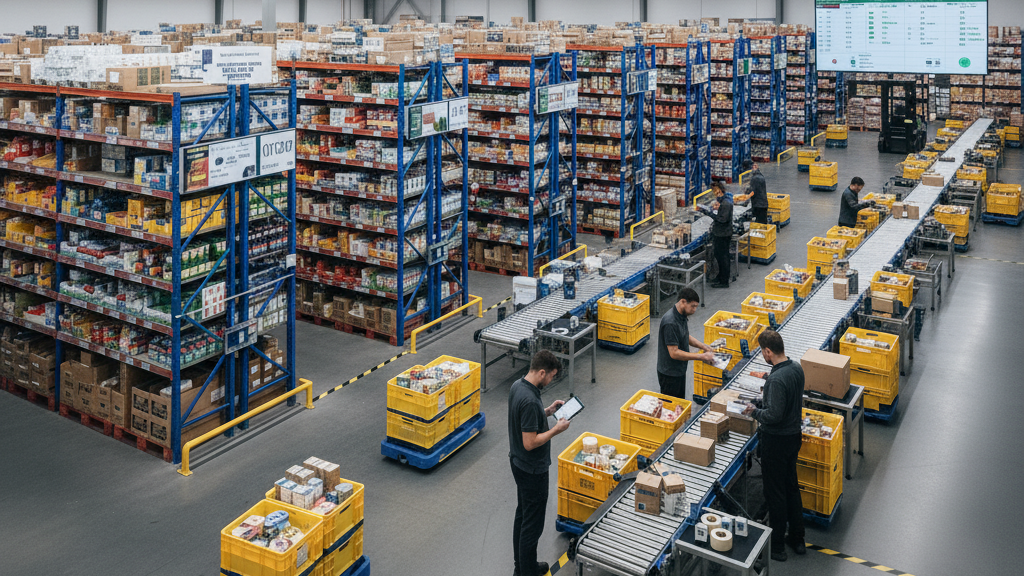
Introduction
In today’s fast-paced retail and quick commerce landscape, customers expect more than just convenience; they expect speed, accuracy, and consistency. While most of the attention goes to delivery apps, last-mile logistics, and customer-facing platforms, the real customer experience is shaped inside the dark store.
Dark stores are fulfillment-only warehouses that power quick commerce to operate behind the scenes. Customers never see them, but every late delivery, wrong item, or missing product can be traced back to inefficiencies in dark store operations. In 2025, the success of quick commerce brands depends not only on customer-facing apps but also on how effectively back-end processes are managed with SOPs, audits, and workforce scheduling.
Why Dark Store Operations Matter More Than Customers Realize
When a customer opens an app to order groceries, medicine, or ready-to-eat meals, they expect delivery in 10–20 minutes. What they don’t see is the complex chain of inventory checks, staff workflows, and compliance processes happening behind the curtain.
A minor failure—such as a stockout, missed hygiene check, or untrained staff member—can directly impact the customer experience. Unlike physical retail, where staff can explain or substitute, dark store errors are magnified because customers only notice the result: a wrong order, a late delivery, or a poor-quality product.
This is why dark store operations are directly tied to customer satisfaction, brand trust, and loyalty.
The Top 5 Back-End Factors That Shape Customer Experience
1. Inventory Accuracy
Inventory management is the foundation of customer trust. A single mismatch between digital stock records and actual shelf availability results in cancelled or incomplete orders.
- Impact on customer experience: Nothing frustrates a customer more than ordering an item that shows as “available” but ends up out of stock.
- Solution: Regular SOP-led cycle counts, automated stock audits, and digital task management ensure accuracy across every dark store.
2. Hygiene & Compliance
For dark stores dealing with groceries, ready-to-eat foods, or pharmaceuticals, compliance isn’t optional. A lapse in hygiene standards can cause not only legal issues but also irreversible brand damage.
- Impact on customer experience: Poor packaging, expired products, or compromised hygiene reduces trust instantly.
- Solution: Smart audit systems standardize hygiene checks, temperature monitoring, and expiry-date tracking so no store compromises on safety.
3. Workforce Efficiency
Dark stores rely on staff for picking, packing, and dispatching. However, workforce inefficiency often leads to delays, errors, or inconsistent service.
- Impact on customer experience: Understaffed shifts cause delivery delays; untrained staff make picking mistakes.
- Solution: Workforce scheduling software and digital SOP training optimize shifts, reduce chaos, and ensure accountability at every level.
4. Order Fulfillment Speed
The essence of quick commerce lies in speed. Every second saved in picking, packing, and dispatching directly improves delivery time.
- Impact on customer experience: Even a five-minute delay can turn a “wow” moment into frustration for the customer.
- Solution: Standardized SOPs for picking and packing, combined with task automation, ensure speed without sacrificing quality.
5. Consistency Across Locations
For brands running multiple dark stores, consistency is often the biggest challenge. One store may deliver in 12 minutes with 99% accuracy, while another struggles with delays and errors.
- Impact on customer experience: Inconsistent service erodes trust and makes customers switch to competitors.
- Solution: Digital SOP management ensures every location operates with the same playbook—from inventory checks to compliance audits.
The Hidden Link Between Operations and Brand Loyalty
Customer experience isn’t just about front-end apps or attractive discounts. It’s about reliability. Customers may forgive one late order, but repeated failures like delayed deliveries, missing items, poor quality lead to churn.
By prioritizing back-end operational excellence through digital SOPs, audits, and workforce scheduling, dark stores can transform reliability into loyalty. In quick commerce, operations = customer experience.
Building Customer-Centric Dark Stores with Digital SOPs & Smart Audits
The future of dark store management lies in digitization and automation. Leading quick commerce and retail brands are already moving away from manual checklists and spreadsheets toward integrated SOP management platforms that bring visibility, accountability, and efficiency.
Here’s how:
- Digital SOPs → Standardize every process across multiple stores.
- Smart Audits → Automate compliance checks and monitor hygiene, safety, and quality.
- Incident Management → Ensure every critical operation is completed on time.
- Workforce Scheduling → Align staff availability with order demand to minimize delays.
By adopting these tools, dark stores can ensure that what happens behind the scenes translates into fast, accurate, and consistent customer experiences.
Conclusion
Dark stores may be invisible to customers, but their operations define the customer journey. From inventory accuracy to staff efficiency, every back-end process directly shapes satisfaction, trust, and loyalty.
To stay competitive in 2025’s quick commerce race, brands must invest in smart audit and SOP management solutions that bring control, visibility, and consistency to every store.
